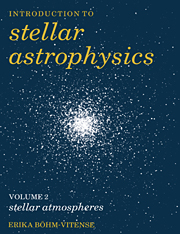Book contents
- Frontmatter
- Contents
- Preface
- 1 Stellar magnitudes and stellar colors
- 2 Stellar spectra
- 3 Temperature estimates for stars
- 4 Basics about radiative transfer
- 5 Radiative transfer in stellar atmospheres
- 6 The depth dependence of the source function
- 7 The continuous absorption coefficient
- 8 The influence of the non-greyness of the absorption coefficient
- 9 The pressure stratification
- 10 Theory of line formation
- 11 The hydrogen lines
- 12 Spectrum analysis
- 13 Basics about non-local thermodynamic equilibrium
- 14 The hydrogen convection zone
- 15 Stellar chromospheres, transition layers, and coronae
- 16 Stellar winds
- Problems
- Appendix LTE model stellar atmospheres
- References
- Index
- Frontmatter
- Contents
- Preface
- 1 Stellar magnitudes and stellar colors
- 2 Stellar spectra
- 3 Temperature estimates for stars
- 4 Basics about radiative transfer
- 5 Radiative transfer in stellar atmospheres
- 6 The depth dependence of the source function
- 7 The continuous absorption coefficient
- 8 The influence of the non-greyness of the absorption coefficient
- 9 The pressure stratification
- 10 Theory of line formation
- 11 The hydrogen lines
- 12 Spectrum analysis
- 13 Basics about non-local thermodynamic equilibrium
- 14 The hydrogen convection zone
- 15 Stellar chromospheres, transition layers, and coronae
- 16 Stellar winds
- Problems
- Appendix LTE model stellar atmospheres
- References
- Index
Summary
In Volume 2 of Introduction to Stellar Astrophysics we will deal mainly with stellar atmospheres. What are stellar atmospheres? We have seen in Volume 1 that stars have temperatures starting at about 3000 K for the coolest stars up to somewhere around 40 000 K for the hottest stars. With such high temperatures stars certainly cannot be solid; they must all be in a gaseous phase. Therefore, the atmosphere cannot be defined as a gaseous layer on top of a solid core as on the Earth; there are no solid cores in the stars. Instead, astronomers define the atmosphere as those layers of the star from which we get the radiation. This means, of course, that this is the layer of the star about which we can obtain direct information. We see no photons from beneath the layer we call the atmosphere. All the radiation which originally came from deeper layers has been absorbed once or many times by atoms in the overlying layers and is finally emitted by an atom in the stellar atmosphere. The photons we receive tell us directly only about the condition of the atoms from which they were last emitted and those are the atoms in the stellar atmosphere. This is why we devote all of Volume 2 to stellar atmospheres.
How thick is this stellar atmosphere? When we discussed absorption in the Earth's atmosphere in Volume 1, we saw that the intensity of a light beam passing through a gas is diminished by a factor e-τ, where τλ is the so-called optical depth of the layer of gas along the beam of light.
- Type
- Chapter
- Information
- Introduction to Stellar Astrophysics , pp. ix - xiiPublisher: Cambridge University PressPrint publication year: 1989

